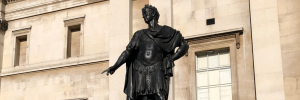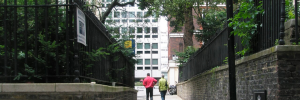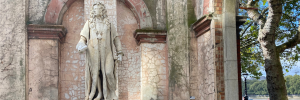Lime Street does not have much of historical interest today. It is dominated by two pieces of well-known modern architecture: the Lloyd’s Building, designed by Richard Rogers, and the Willis Building by Foster and Partners. Otherwise, it is undistinguished. In the late seventeenth century, however, this small City lane briefly became the site of religious controversy.
Here in 1686 for the first time since the reign of Queen Mary a Catholic place of worship was opened in England. The new chapel faced two big problems: Catholic worship was illegal; and most Londoners were rabidly hostile.
James II had ascended peacefully to the throne in 1685, in spite of earlier attempts to exclude him because of his Catholicism. Early in his reign he had issued dispensations, preventing Catholics from being persecuted under the Test Acts, requiring them to take an oath of loyalty to the Anglican church, and from being fined and pursued in the courts for recusancy – the failure to attend Anglican services.
This ‘dispensing’ power, claimed by the king, was controversial. Many argued that in putting statutes aside and shielding his co-religionists from punishment James was acting illegally. His next step to set up a Catholic chapel in the City was seen as even more of an assault on English liberty and the Protestant religion. It was furthermore interpreted, quite rightly, as an attempt to establish a precedent, whereby further Catholic places of worship could be opened. The position of Lime Street in the heart of the capital may well have added to its attractions for the king.
James wanted to get round the ban on Catholic worship by a loophole. Catholic diplomats were allowed to have their own chapels where they and their servants could practice in private the official religion of the state they were representing. James II persuaded James Stamford, the envoy of the Elector Palatine, to take on the lease of a property in Lime Street and convert it into a chapel.
The king was bending the rules. Diplomats’ private chapels were up to this point exclusively in Westminster, near the royal palaces of Whitehall and St James’s. They were also small. The building in Lime Street was clearly much larger than required for the religious practices of James Stamford’s family and servants. And finally, Stamford himself was English; not a foreign diplomat.
The Elector himself would later deny that he knew anything about the chapel, and furthermore that it was constructed against his wishes.
In late March 1686 the lord mayor, Sir Robert Geffrye tried to halt work on the chapel on the grounds that it was illegal. The fact that Geffrye was a Tory is one indication of how James II was alienating the political constituency that had been the bedrock of support for the crown in the later years of Charles II and which had helped assure his own accession.
The chapel opened in April, with a hostile crowd following the priests on their way to Lime Street. The local constables and trained bands came to restore order, but their efforts on this and the following Sundays when trouble flared again, were half-hearted. The chapel was demolished by a mob after the flight of James II in 1688.
–
Ian McDiarmid is a qualified City of London Tour Guide who delivers guided walks and private tours in London. View all of Ian’s walking tours.



